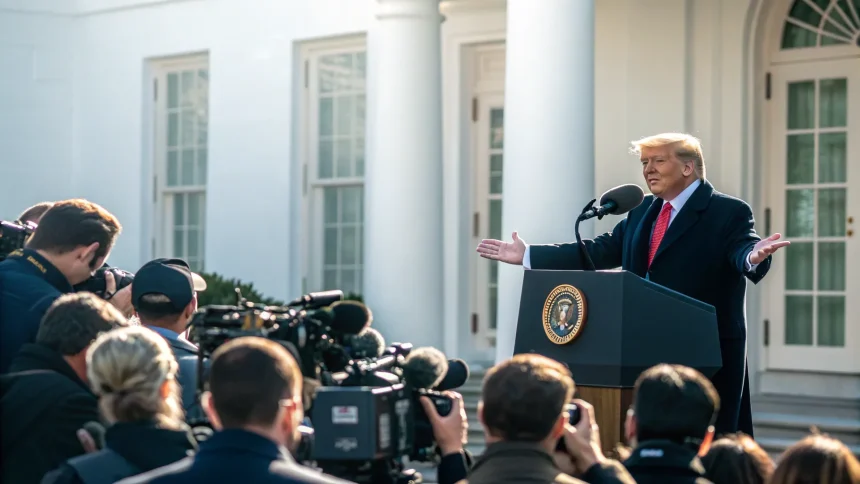In new remarks, former President Donald Trump argued that recent Republican setbacks happened because his name was not on the ballot and due to the federal government shutdown. His framing puts fresh attention on how national figures and major disruptions can shape voter behavior and party momentum.
Trump’s comments come as Republicans assess why they underperformed in key races and how to adjust strategy ahead of the next election cycle. Party strategists are weighing whether turnout dynamics, the shutdown’s fallout, or broader voter concerns carried the most weight.
“The reason that Republicans lost big was because I was not on the ballots and because of the federal government shutdown.” — Donald Trump
Historical Patterns and Recent Results
Midterm elections often punish the party that holds the White House. Over decades, the president’s party has usually lost seats in the House during midterms. In 2018, Democrats gained control of the House while Republicans expanded their margin in the Senate, reflecting split voter sentiment across regions.
Government shutdowns have also left a mark. The 2018–2019 shutdown lasted 35 days, the longest in U.S. history, disrupting services and federal paychecks. Past shutdowns have hurt governing parties in public opinion, though the electoral effects can vary by state and district.
Experts note that many factors typically converge to shape outcomes: the economy, local candidates, fundraising, and salient issues like healthcare, border security, and abortion policy. It is uncommon for a single cause to explain broad swings.
Turnout, Ticket Effects, and Trump’s Claim
Trump’s argument rests on two ideas: that his personal presence on the ballot lifts Republican turnout, and that the shutdown dampened support for GOP candidates. His rallies and endorsements have driven intense media attention and energized core supporters in past cycles.
But turnout cuts both ways. Trump’s visibility has also motivated strong turnout among Democrats and independents who oppose him. In suburban districts that shifted blue in 2018, voters cited healthcare costs, political tone, and stability as major concerns, areas where GOP messaging struggled to gain traction.
Analysts say the shutdown’s impact likely varied. Federal workers and contractors in affected regions felt direct strain, and polls at the time showed public frustration with Washington gridlock. Yet in some conservative districts, border policy and spending battles remained galvanizing themes for GOP voters.
Inside the Republican Debate
Republican strategists are divided on how much weight to give Trump’s theory. Some agree that his name on the ticket boosts base turnout, pointing to 2016 and 2020 participation rates. Others argue the party must broaden its appeal with suburban and younger voters by focusing on inflation, public safety, and education rather than relitigating shutdown politics.
- Pro-Trump operatives emphasize turnout and party unity.
- Skeptics push for issue-driven outreach beyond the base.
- State parties weigh local tailoring over national messaging.
Democrats, for their part, say the results reflect voter fatigue with chaos and a desire for stability. They credit grassroots organizing, early voting efforts, and consistent messaging on healthcare and rights.
Data Points and What to Watch
Historical markers offer guideposts but not certainty. Midterm penalties are common, shutdowns have mixed electoral effects, and split outcomes—House one way, Senate the other—are not unusual. The decisive factor in upcoming cycles may be persuasion among swing voters combined with turnout among core supporters on both sides.
Key indicators to monitor include voter registration trends in suburbs, small-dollar fundraising, and the performance of first-time candidates. State-level ballot measures can also drive turnout and shape down-ballot races, sometimes independent of national figures.
Trump’s comments signal he intends to remain central to the party’s message. Whether that helps or hurts will depend on district maps, candidate quality, and the salience of pocketbook issues versus national drama.
For Republicans, the path ahead likely requires two tracks: energize loyal voters while rebuilding trust with moderates who have drifted away. For Democrats, the challenge is to maintain coalition turnout without an automatic foil.
The latest debate within the GOP—sparked by Trump’s claim—shows the party is still searching for a winning formula. The test will come as campaigns ramp up, policy fights resume, and voters judge which side offers stability, results, and a clear plan for the economy.







